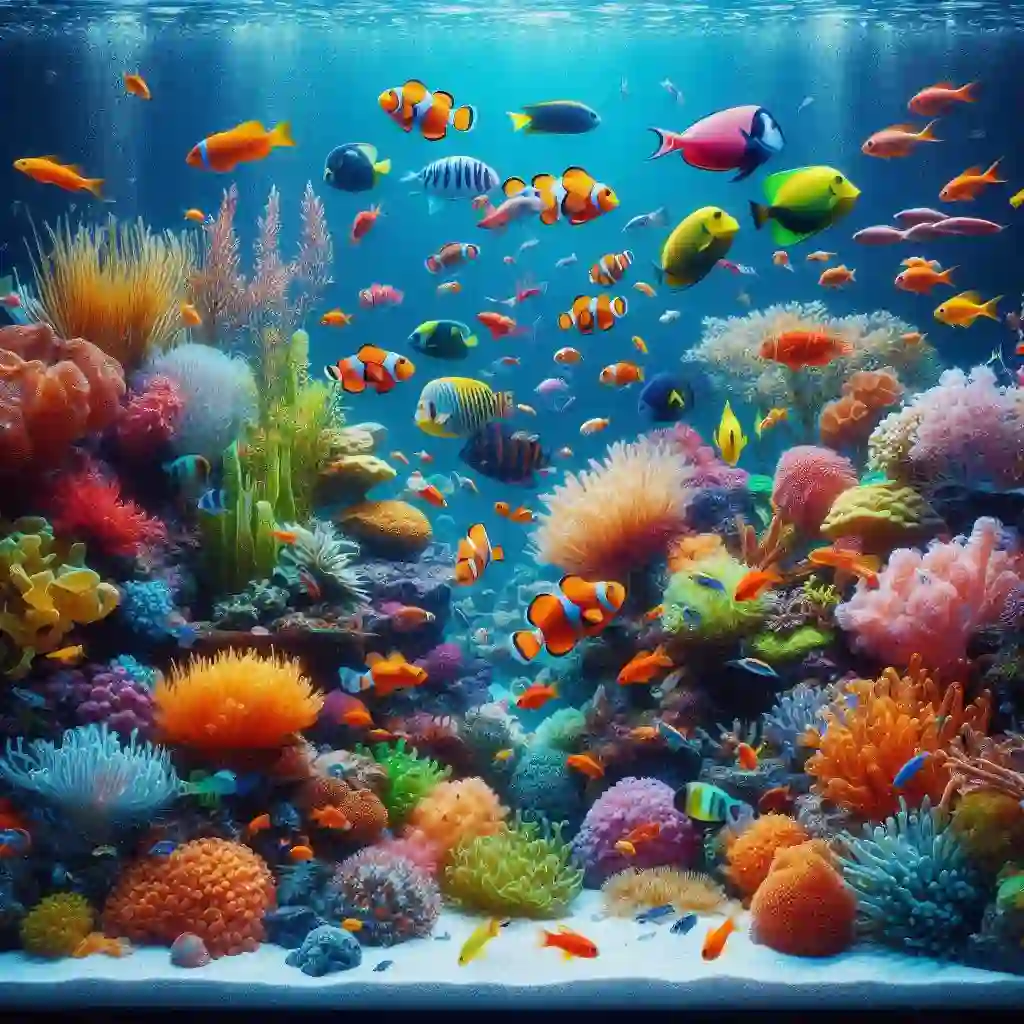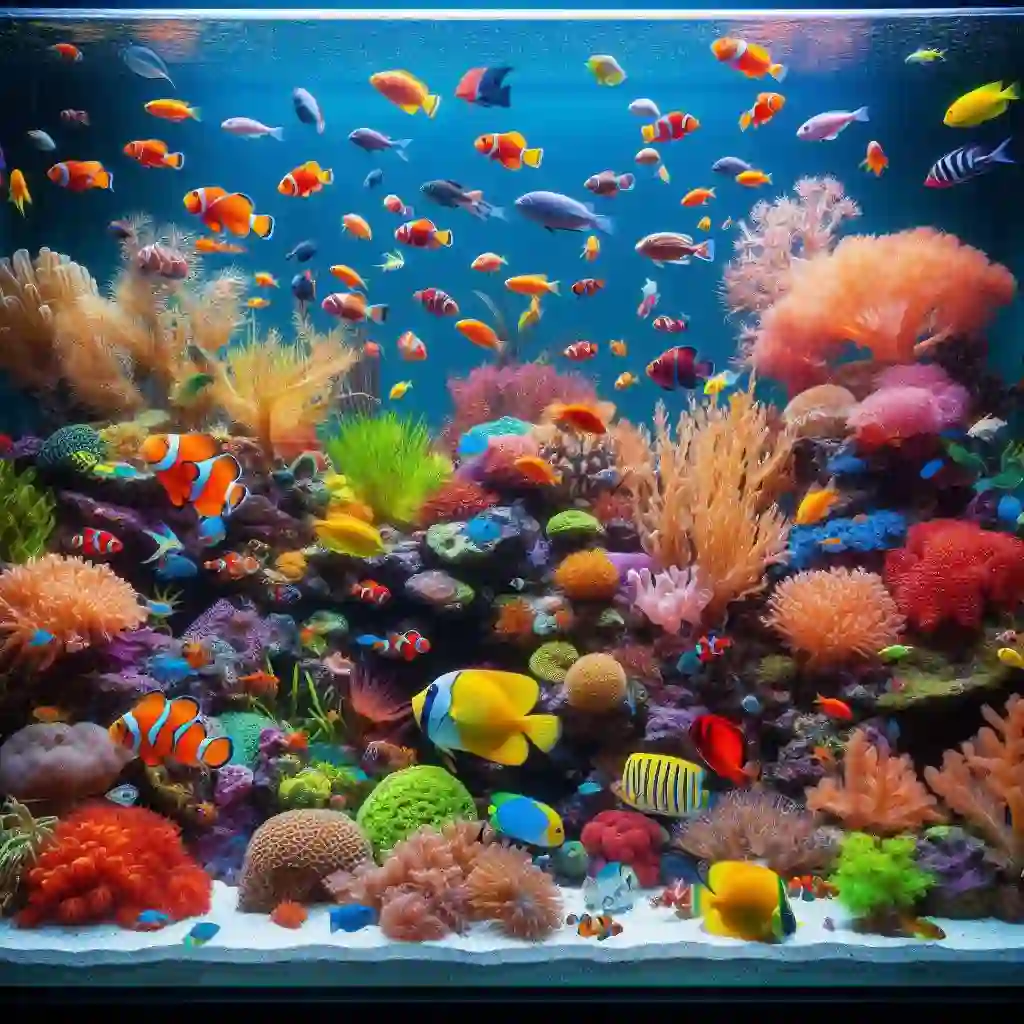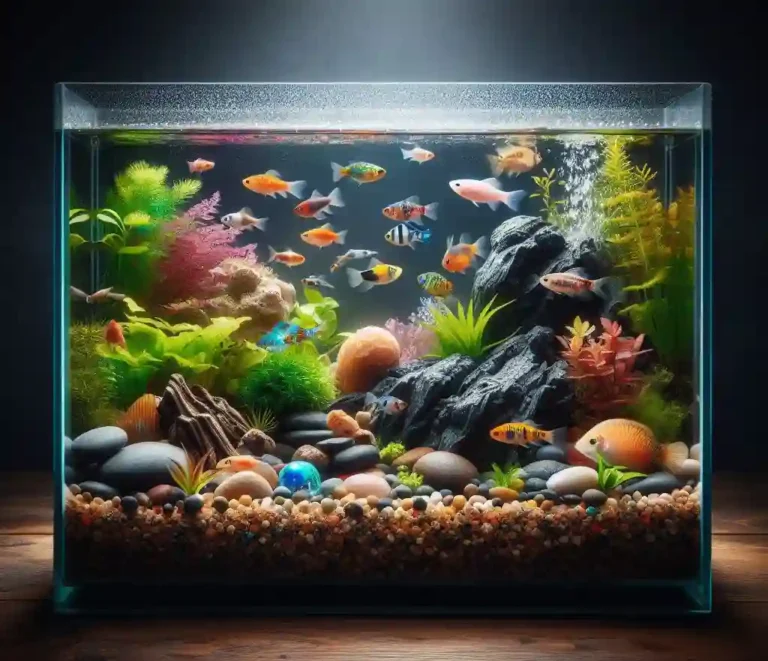How to Lower pH in Aquarium with Vinegar: The Acid Test
How to Lower pH in Aquarium with Vinegar? While many aquarium owners focus on maintaining a stable pH level, some aquatic species thrive in slightly acidic environments.
If you’re looking for a natural and effective way to lower pH levels in your aquarium, vinegar may be the solution you’ve been searching for.
In this guide, we’ll explore the benefits of using vinegar to lower pH levels in your aquarium, as well as provide a step-by-step guide on how to do it safely and effectively.
Lower pH in Aquarium with Vinegar: A Quick Guide

How to Lower pH with Vinegar
- Calculate Vinegar Dosage: Use the formula: Vinegar dosage (mL) = (pH difference x aquarium volume in liters) / 10.
- Dilute Vinegar: Dilute the calculated amount of vinegar with water according to the recommended ratio (typically 1 part vinegar to 10 parts water).
- Add Vinegar Solution: Gradually add the vinegar solution to the aquarium over a period of 1-2 hours to prevent sudden changes in pH levels.
- Monitor pH Levels: Regularly test pH levels to ensure they remain within a safe range for your aquatic friends.
Safety Precautions
- Always dilute vinegar with water before adding it to the aquarium.
- Avoid sudden changes in pH levels, as they can shock or harm aquatic life.
- Monitor aquarium conditions, including water temperature, ammonia, nitrite, and nitrate levels, to ensure the vinegar addition is not causing any adverse effects.
Tips and Reminders
- Use food-grade vinegar that is free from additives and contaminants.
- Avoid using vinegar in saltwater aquariums.
- Regularly test pH levels to ensure they remain within a safe range for your aquatic friends.
Understanding pH Levels in Aquariums: Why pH Matters
- pH affects aquatic life: Most freshwater aquarium fish and plants prefer a slightly acidic to neutral pH, ranging from 6.5 to 7.5. If the pH level becomes too high or too low, it can cause stress, illness, and even death in aquatic life.
- pH impacts fish health: A pH level above 8 can lead to respiratory distress in fish, while a pH level below 6 can cause damage to their scales and fins.
- pH affects nutrient availability: An unstable pH can affect the bioavailability of essential nutrients, making it difficult for aquatic plants to absorb the necessary nutrients for growth.
- pH stability is crucial: By maintaining a stable and optimal pH level, aquarium owners can create a healthy environment that supports the well-being of their aquatic friends.
The Science Behind Vinegar: How it Lowers pH

- Acetic acid dissociation: When vinegar is added to water, the acetic acid dissociates into hydrogen ions (H+) and acetate ions (CH3COO-).
- Acid-base neutralization: The hydrogen ions then react with the hydroxide ions (OH-) in the water, forming water (H2O) and reducing the pH level.
- pH reduction: As the pH level decreases, the acidity of the water increases, making it more suitable for aquatic life that thrive in slightly acidic environments.
- Neutralizing excess alkalinity: The acidity of vinegar also helps to neutralize excess alkalinity in the water, which can contribute to high pH levels.
- Creating a balanced environment: By adding vinegar to the aquarium, aquarium owners can safely and naturally lower the pH level, creating a more balanced and healthy environment for their aquatic friends.
Preparing Vinegar for Aquarium Use: Safety Precautions
- Dilute the vinegar: Always dilute the vinegar with water according to the recommended ratio (typically 1 part vinegar to 10 parts water) to avoid sudden changes in pH levels.
- Use food-grade vinegar: Only use food-grade vinegar, as it is free from additives and contaminants that can harm aquatic life.
- Avoid sudden changes: Gradually introduce the vinegar solution into the aquarium to prevent sudden changes in pH levels, which can shock or even kill aquatic life.
- Monitor pH levels: Regularly monitor pH levels to ensure they remain within a safe range for your aquatic friends.
- Avoid over-acidification: Be cautious not to over-acidify the water, as this can be detrimental to aquatic life.
- Consult a veterinarian or aquarium expert: If you’re unsure about using vinegar in your aquarium or have concerns about its safety, consult a veterinarian or aquarium expert for guidance.
Calculating the Right Amount of Vinegar: A Step-by-Step Guide

Step 1: Determine the Current pH Level
Measure the current pH level of your aquarium using a reliable pH test kit.
Step 2: Determine the Desired pH Level
Decide on the desired pH level for your aquarium, taking into account the specific needs of your aquatic friends.
Step 3: Calculate the pH Difference
Calculate the difference between the current pH level and the desired pH level.
Step 4: Calculate the Vinegar Dosage
Use the following formula to calculate the amount of vinegar needed:
Vinegar dosage (mL) = (pH difference x aquarium volume in liters) / 10
Step 5: Dilute the Vinegar
Dilute the calculated amount of vinegar with water according to the recommended ratio (typically 1 part vinegar to 10 parts water).
Step 6: Add the Vinegar Solution
Gradually add the vinegar solution to the aquarium, monitoring pH levels regularly to avoid sudden changes.
Adding Vinegar to Your Aquarium: A Safe and Gradual Approach
Step 1: Prepare the Vinegar Solution
Dilute the calculated amount of vinegar with water according to the recommended ratio (typically 1 part vinegar to 10 parts water).
Step 2: Turn Off Pumps and Filters
Turn off all pumps and filters in the aquarium to prevent the vinegar solution from circulating too quickly and causing sudden changes in pH levels.
Step 3: Add the Vinegar Solution
Gradually add the vinegar solution to the aquarium over a period of 1-2 hours to prevent sudden changes in pH levels.
Step 4: Monitor pH Levels
Regularly monitor pH levels using a reliable pH test kit to ensure they remain within a safe range for your aquatic friends.
Step 5: Monitor Aquarium Conditions
Closely monitor aquarium conditions, including water temperature, ammonia, nitrite, and nitrate levels, to ensure the vinegar addition is not causing any adverse effects.
Step 6: Make Adjustments as Needed
Make adjustments to the vinegar dosage or addition rate as needed to maintain a stable and healthy environment for your aquatic friends.
Monitoring pH Levels: How to Track Progress and Adjust
Step 1: Regular pH Testing
Regularly test pH levels using a reliable pH test kit to ensure accurate readings.
Step 2: Track pH Levels
Track pH levels over time to monitor progress and identify any trends or fluctuations.
Step 3: Adjust Vinegar Dosage
Adjust the vinegar dosage based on pH level readings. If pH levels are not decreasing as expected, increase the vinegar dosage. If pH levels are decreasing too quickly, decrease the vinegar dosage.
Step 4: Monitor Aquarium Conditions
Monitor aquarium conditions, including water temperature, ammonia, nitrite, and nitrate levels, to ensure the vinegar addition is not causing any adverse effects.
Step 5: Make Adjustments as Needed
Make adjustments to the vinegar dosage or addition rate as needed to maintain a stable and healthy environment for your aquatic friends.
Tips and Reminders
- Always use a reliable pH test kit to ensure accurate readings.
- Track pH levels at the same time each day to ensure consistent readings.
- Be patient and make adjustments gradually to avoid sudden changes in pH levels.
- Monitor aquarium conditions regularly to ensure the vinegar addition is not causing any adverse effects.
Common Mistakes to Avoid When Using Vinegar in Aquariums
Mistake 1: Adding Vinegar Too Quickly
Adding vinegar too quickly can cause sudden changes in pH levels, shocking your aquatic friends. Always add vinegar gradually to prevent sudden changes.
Mistake 2: Not Monitoring pH Levels
Failing to monitor pH levels regularly can lead to over-acidification or under-acidification, harming your aquatic friends. Regularly test pH levels to ensure they remain within a safe range.
Mistake 3: Using Undiluted Vinegar
Using undiluted vinegar can be too harsh for your aquatic friends. Always dilute vinegar with water according to the recommended ratio (typically 1 part vinegar to 10 parts water).
Mistake 4: Not Considering Water Volume
Failing to consider the water volume of your aquarium can lead to inaccurate vinegar dosages. Always calculate the vinegar dosage based on the aquarium’s water volume.
Mistake 5: Ignoring Aquarium Conditions
Ignoring aquarium conditions, such as water temperature, ammonia, nitrite, and nitrate levels, can lead to adverse effects. Monitor aquarium conditions regularly to ensure the vinegar addition is not causing any harm.
Long-Term Maintenance and pH Stability: Tips for Success
Tip 1: Regular Water Changes
Regular water changes (10-15% every week) help maintain water quality and prevent pH fluctuations.
Tip 2: Monitor pH Levels Regularly
Regularly test pH levels to ensure they remain within a safe range for your aquatic friends.
Tip 3: Adjust Vinegar Dosage as Needed
Adjust the vinegar dosage as needed to maintain a stable pH level.
Tip 4: Monitor Aquarium Conditions
Regularly monitor aquarium conditions, including water temperature, ammonia, nitrite, and nitrate levels, to ensure the vinegar addition is not causing any adverse effects.
Tip 5: Perform Regular Water Tests
Perform regular water tests to ensure water quality is within acceptable ranges.
Tip 6: Avoid Over-Acidification
Avoid over-acidification by monitoring pH levels and adjusting the vinegar dosage accordingly.
Tip 7: Consider Automating pH Control
Consider automating pH control using a pH controller or aquarium computer to ensure consistent pH levels.
FAQs
Q: Is it safe to use vinegar in my aquarium?
A: Yes, vinegar is a safe and natural way to lower pH levels in aquariums when used properly.
Q: How do I calculate the right amount of vinegar to add to my aquarium?
A: Use the formula: Vinegar dosage (mL) = (pH difference x aquarium volume in liters) / 10.
Q: Can I use any type of vinegar in my aquarium?
A: No, only use food-grade vinegar that is free from additives and contaminants.
Q: How often should I add vinegar to my aquarium?
A: Add vinegar as needed to maintain a stable pH level, but avoid over-acidification.
Q: Can I use vinegar to raise pH levels in my aquarium?
A: No, vinegar is only effective for lowering pH levels. To raise pH levels, use a pH increaser or baking soda.
Q: Are there any risks associated with using vinegar in my aquarium?
A: Yes, risks include over-acidification, sudden changes in pH levels, and harming aquatic life if not used properly.
Q: Can I use vinegar in a saltwater aquarium?
A: No, vinegar is not recommended for saltwater aquariums as it can cause more harm than good.
Q: How long does it take to see results from using vinegar in my aquarium?
A: Results may vary, but you should start to see changes in pH levels within a few hours to a few days.

Hello, I’m Aria Cooper, the heart and soul behind Swimmy Buddies. As a devoted fish aficionado, I share my aquatic adventures and expertise to inspire your own underwater explorations. 🐠🌊







